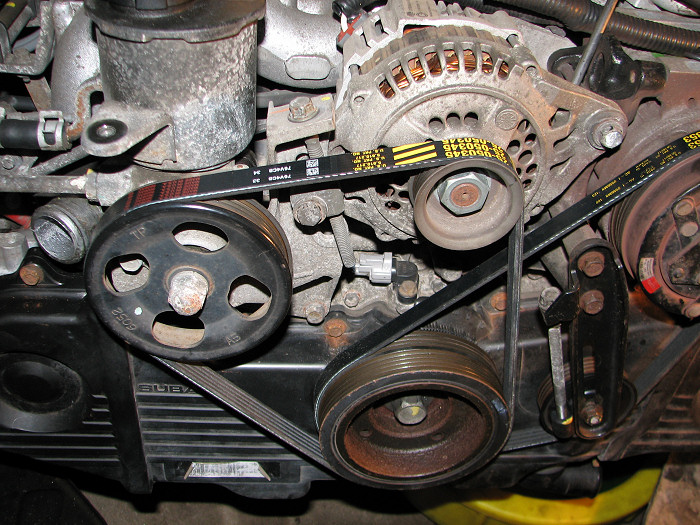
The radiator fan belt is attached to a pulley, or series of pulleys, and turns your radiator fan at a speed sufficient enough to draw ambient outside air into the radiator. Some vehicles use a belt dedicated to turning the radiator fan only; however, many vehicles use a serpentine belt to not only control the radiator fan but many other components of the vehicle such as the power steering, air conditioning and even the alternator. Serpentine belts or radiator belts are usually designed to last up to 150,000 miles.
These belts occasionally wear out. Older vehicles (those more than 8 to 10 years old) may not use the same type of high quality belts used in newer vehicles, and may need to be replaced every 40,000 or 50,000 miles.
Symptoms of a Bad Radiator Fan Belt or Serpentine Belt
One of the very first symptoms that a radiator fan belt or serpentine belt going bad is squealing or screeching sounds that come from the engine area. The sound may only last for a minute or two after starting the vehicle. Over time, the squeaky belt sound will grow louder in volume and continue for longer periods of time. The volume of the sound will vary from vehicle to vehicle, but it’s almost always annoying and noticeable.
The noise is the result the belt slipping off the pulley because of corrosion on the belt. Regardless of whether the sound occurs only when you’re starting the vehicle or when accelerating, the noise usually indicates the belt needs to be replaced.
Visual Signs of Radiator Fan Belt Damage
One of the easiest ways to diagnose problems with a radiator fan belt or serpentine belt is simply to look at the condition of the belt. A worn or slipping belt will usually show signs of damage such as fraying or cracking, and can easily be seen using a flashlight and a small mirror to view the underside of the belt.
Many mechanics recommend that you change a worn belt whenever there are two or more cracks per inch in the belt. Worn belts can also show signs of cording and ribbing. If you have these types of defects in your radiator fan belt, consider purchasing a new belt right away. If you have a crack that is deeper than half the thickness of the belt, you should change the belt immediately, because it will probably break or snap soon.
How to Replace a Radiator Fan Belt
Most vehicles now use a serpentine belt that should last well over 100,000 miles. However, there may be times when the belt becomes cracked, worn or otherwise damage and needs to be replaced.
What You Will Need
- A new replacement serpentine belt
- Wrenches
- A serpentine belt diagram for your vehicle
Locate the Serpentine Belt Tension Adjustment
Locate the bolts and mounts used to adjust the tension for the serpentine belt. Depending upon the make and model, this may be hard to access. You may have to jack up your vehicle in order to find the bolt mount assembly used to tighten the serpentine belt.
Loosen the Tension on the Serpentine Belt
Loosen the tension on the serpentine belt adjustment and remove the damaged serpentine belt. Leave the tension slightly relaxed so that you can install the new belt.
Install the New Serpentine Belt
Carefully follow the serpentine belt diagram for your vehicle, and feed the new belt through the series of pulleys that the belt controls. The path that a serpentine belt follows can be quite complex and confusing, so make sure that you follow the path of the diagram exactly. Always double check and triple check the path of the belt before continuing.
Tighten the Serpentine Belt
Turn the bolts on the mounting assembly that controls the tension of the serpentine belt. Tighten the belt until there is no longer any play anywhere in the belt path. Once you have adjusted the tension on the new serpentine belt, make a final inspection of the belt system, and check to be sure that the belt is looped through the system correctly.
Turn on the Engine
After you have installed the new serpentine belt, turn on your engine. Carefully inspect the engine while it is running, and ensure that all pulleys are being turned by the serpentine belt. Also, check for vibrations or other signs that the serpentine belt may be loose and need more tightening.
Check the belt for shimmying or flapping, as these are also indicators that the belt tension needs to be adjusted. If the belt still seems loose, turn off the car engine and readjust the tension of the belts in the same way you did earlier.
SOURCE: carsdirect
